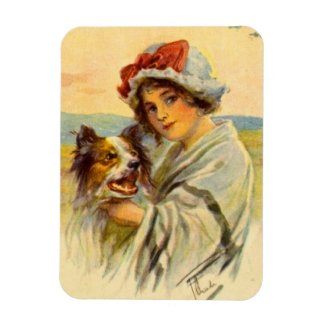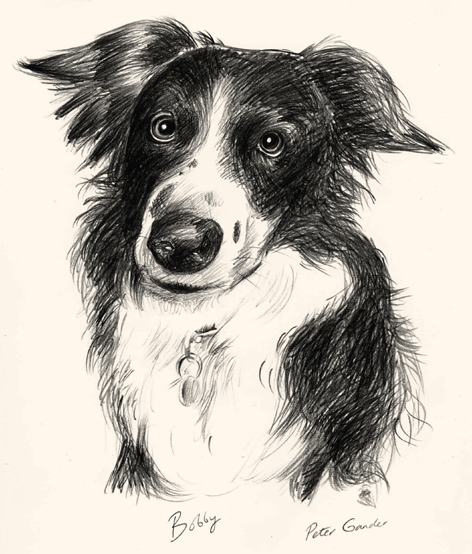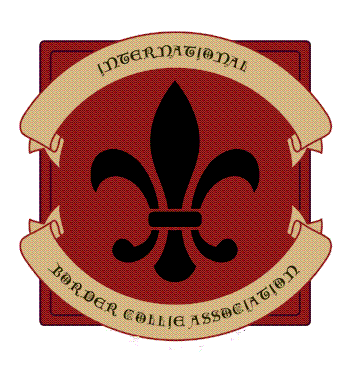
The
Border Collie From where did the Border
Collie originate? The border collie originated sometime during the
1800’s. However the Border Collie as we
know it today did not originate until 1915 from the borders of
What is the lifespan of the
Border Collie? The average Border Collie will live
10-14 years. What physical attributes
should I take into account when looking at a Border
Collie? Temperament: The
Border Collie is energetic, intelligent, keen, alert, and responsive. An intense
worker of great tractability, it is affectionate towards friends but may be
sensibly reserved towards strangers. When approached, the Border Collie should
stand its ground. It should be alert and interested, never showing fear,
dullness, or resentment. Any tendencies toward viciousness, nervousness or
shyness are very series faults. Size: Males
should be 19” – 22” at
withers The body, from
prosternum to point of buttocks, is slightly longer than the height at the
withers with the length to height ratio being approximately 10:9. Bones must be
strong, medium being correct but lighter bones is preferred over heavy. Overall
balance between height, length, weight and bone is crucial and is more important
than any absolute measurement. Dogs must be presented in hard working condition.
Excess body weight is not to be mistaken for muscle or substance. Any single
feature of size appearing out of proportion should be considered a
fault. General
Appearance: The general
appearance should be that of a well proportioned dog, the smooth outline showing
quality, gracefulness and perfect balance, combined with sufficient substance to
ensure that it is capable of enduring long periods of activity in its intended
task as a working sheepdog. Head:
The skull
is broad and flat between the ears, slightly narrowing to the eye with a
pronounced stop cheeks deep but not prominent. The muzzle, tapering to the nose,
is strong and the same length as the skull. The lips are tight and clean and the
nose is large with open nostrils. The nose colour in all dogs will be a solid
colour with no pink or light pigment, and shall compliment the backgrounds
colour of the dog. Eyes:
The eyes
are set wide apart, oval shaped of moderate size. Blue eyes (with one, both or part of one of
both eyes being blue) in dogs other than merle, are acceptable but not
preferred. Eye rims should be fully pigmented, lack thereof considered a fault
according to degree. Ears: Ears
are
of medium size, set well apart, one or both carried erect and/or semi-erect
(varying from ¼ to ¾ of the ear erect). When semi-erect, the tips may fall
forward or outward to the side. Ears are sensitive and
mobile. Mouth:
The teeth
should be sound, strong and evenly spaced. Neck: Is of proportional
length to the body, strong and
muscular, slightly arched and blending smoothly into the
shoulders. Forequarters:
Forelegs should be parallel when viewed from front. Pasterns slightly
sloping when viewed from side. The shoulder blades are long, well laid back and
well-angulated to the upper arm. Shoulder blades and upper arms are equal in
length. Body: The body is moderately
long with well-sprung
ribs tapering to a fairly deep and moderately broad chest.. The loins are broad,
deep and muscular with well turned stifles and strong hocks, well let down, and
when viewed from the rear are straight and parallel. Hindquarters: Broad and muscular,
in profile sloping
gracefully to the lowest tail. The thighs are long, broad, deep and muscular.
Stifles are well turned with strong hocks that may be either parallel or very
slightly, turned in, Dewclaws should be removed. Feet, although slightly
smaller, are the same as front. Feet: Oval in shape,
pads deep, strong and sound,
toes moderately arched and close together. Nails short and
strong. Tail: The tail is
set on low and is moderately long
with the bone reaching at least to the hock. The ideal tail carriage is low when
the dog is concentrating on a given task and may have a slight upwards swirl at
the end of the shepherd’s crook. In excitement, it may be raised proudly and
waved like a banner, showing a confident personality. A tail curved over the
back ifs a fault. Coat: Two
varieties are permissible, both having close-fitting, dense, weather resistant
double coats with the top coat either straight or wavy and coarser in texture
than the undercoat which is soft, short, and dense. The rough variety is medium
length without being excessive. Forelegs, haunches, chest and underside are
feathered and the coat on the face, ears, feet, front of legs, is short and
smooth. The smooth variety is short overt the entire body, is usually coarser in
texture than the rough variety and may have slight feathering on forelegs,
haunches, chest, and ruff. Neither coat type is preferred over the other.
Seasonal shedding is normal and should not be panelized. The Border Collie’s
purpose as an activity working herding dog shall be clearly evident in its
presentation. Excess hair on the feet, hock, and pastern areas may be neatened
for the show ring. Whiskers are untrimmed. Dogs that are overly groomed (trimmed
and/or sculpted) should be penalized according to the
extent. Color: The
Border Collie appears in all colors or combination of colors and/or markings.
Solid color, bi color, tri color, merle and sable dogs are to be judged equally
with no one color or pattern preferred over another. White markings may be clear
white or ticked to any degree. Random white patches, on the body and head are
permissible but should not predominate. Color and markings are always secondary
to physical and evaluation gait. Gait: The Border
Collie is an agile dog, able to suddenly change speed and direction while
maintaining balance and grace. Endurance is its trademark. The Border Collie’s
most used working gaits are the gallop and moving crouch (stealth) which convert
to a balanced and free trot, with minimum lift of the feet. The head is carried
level with or slightly below the withers. When shown, Border Collies should move
on a loose lead and at moderate speed, never raced around the ring with the head
held high. When viewed from the side the trot is not long striding, yet covers
the ground with minimum effort, exhibiting facility of movement rather than a
hard driving action. Exaggerated reach ad drive at the trot are not useful to
the Border Collie. The top line is firm. Viewed from the front, action is
forward and true without wasted motion. Viewed from the rear, hindquarters drive
with thrust and flexibility with hocks turning neither in nor out, moving close
together but never touching. The legs, both front and rear, tend to converge
toward the center line as speed increases. Any defiance that detracts from
efficient movement is a fault. Grooming: Few
dogs are as work-oriented as the Border Collie. This is a dog that needs a job.
It needs a lot of physical and mental activity every day to satisfy its quest
for work. It can live outdoors in temperate to cool climates, but it enjoys
being with its family inside as well. This is a dog that cannot live in an
apartment and that should preferably have ready access to a yard. Its coat needs
brushing or combing twice weekly. Faults: Any departure
from the foregoing points
should be considered a fault and the seriousness of the fault should be in exact
proportion to its degree. Are there any genetic defects
I need to know about when looking at a Border
Collie? The Border Collie like many other
breeds are not free from genetic defects.
Listed below you will find genetic defects that you may encounter with
your Border Collie. Hip Dysplasia
Collie Eye
Anomaly Epilepsy Progressive
Retinal Atrophy Malignant Hyperthermia Elbow dysphasia
Osteochondritis
Dissesans Focal/Multifocal Acquired
Retinopathy
Malignant Hyperthermia What is Hip
Dysplasia? Hip Dysplasia is by far
the most common genetic disease that affects the Border Collie. Factors that
contribute to the development of hip dysplasia
causes the hip joint to be damaged. This damage is referred to as
osteoarthritis, also known as degenerative joint disease. Degenerative joint disease is manifested by
cartilage and bone breakdown and irregular bony remodeling in response to
stresses and inflammatory processes in the joint. What is Collie
Eye Anomaly (CEA)? Collie Eye Anomaly is an abnormal
development of the eye. Mild cases are characterized by lack of development of
the choroid, which is the vascular layer of the back of the eye (choroidal
hypoplasia), and vascular tortuosity. In more severe cases, the dog may have
patchy areas where the choroid is missing and bare sclera is visible. Colobomas
are outpouches of the sclera, and may be found in the most serious presentation
of CEA. The colobomas may be small or large and may affect the optic disc or be
adjacent to the optic disc. Dogs with colobomas have a higher incidence of
development of a retinal detachment, or retinal hemorrhage, or both which can
result in blindness.
What is
Epilepsy? Epilepsy is a neurological seizure
disorder, which can be extremely serious. Although eptileptic seizures can
usually be controlled by medication, that's not always the case. Dogs have been
known to die of uncontrollable seizures. Unfortunately, there is no test at this
time. What is Progressive Retinal Atrophy
(PRA)? Progressive Retinal
Atrophy (PRA) is a
progressive disease where tissue in the retina of the eye is destroyed. It may
initially be noticed as decreased ability of the dog to see at night, and may
eventually progress to total blindness. Progressive Retinal
Atrophy in Border Collies in the
What is Malignant
Hyperthermia? Malignant Hyperthermia is a very
serious but extremely rare condition that affects some Border Collies. Typical
symptoms include staggering after a brief period (5 to 10 minutes) of exercise.
If left to run they will collapse. Body temperatures shoot up extremely high
and take a long time to return to normal even in cold weather. Any exercise or
stress can trigger an attack. If the dog's temperature goes to high it can
trigger seizures, strokes or even death. A Border Collie with this condition
must have their exercise carefully monitored and controlled. What is
Elbow Dysplasia? Elbow dysplasia
is the term for an elbow joint that is malformed. The mechanism of the malformation is unclear
but it may be due to differences in the growth rates of the three bones that
make up the elbow joint, particularly the humerus and ulna. In mildly affected
dogs the only consequence may be arthritis. In more severely affected dogs,
osteochondritis dissecans (OCD), fragmented medial coronoid processes and united
anconeal processes can result from the stress in the
joint. What
is Osteochondritis Dissecans
(OCD)? What
is Focal/Multifocal Acquired Retinopathy
(FMAR)? Focal/Multifocal Acquired
Retinopathy
(FMAR) is a inflammatory eye disease.
This is common in many working breeds and is
probably the most frequently seen retinal lesion in Border Collies. This can
lead to impaired vision and sometimes leading to blindness. Males are more prone
to this defect than females.
Are Border Collies Good With Children? Click on this link to find out. Purchase I.B.C.A. bumper stickers, decals, note cards and more...  |
|||||||||||
|
 Vintage Border Collie Refrigerator Magnet~Flexible by whollysheep Check out other Vintage Magnets at zazzle.com Purchase I.B.C.A. bumper stickers, decals, note cards and more...
|
|||||||||||







